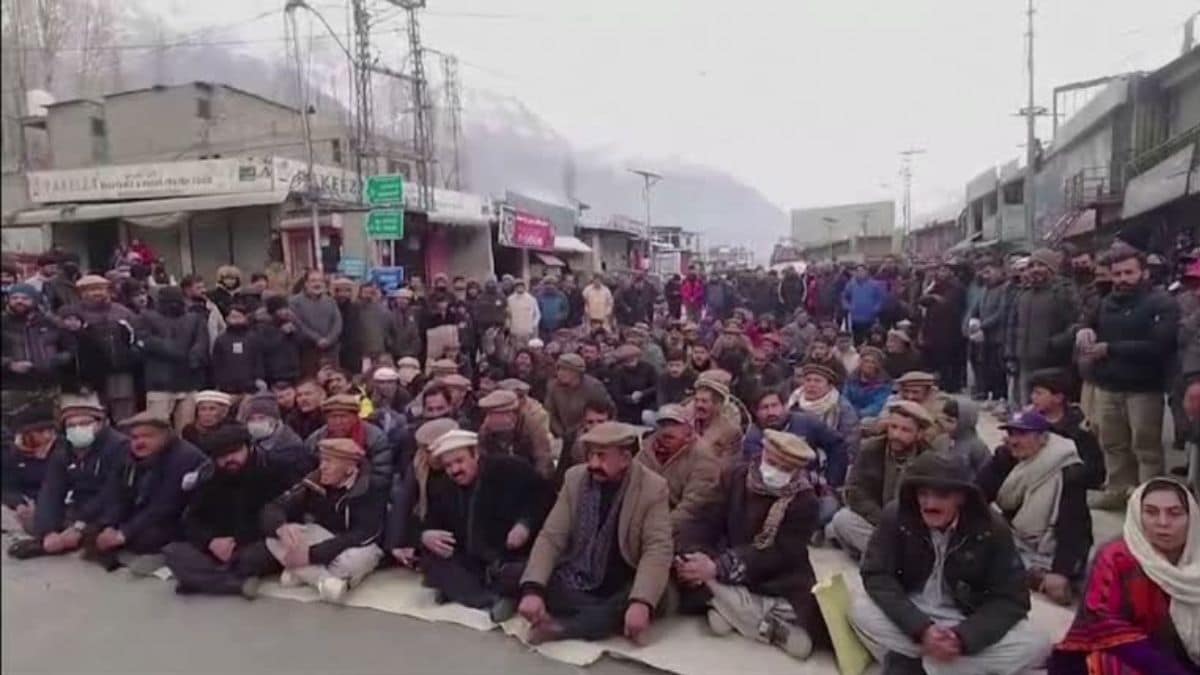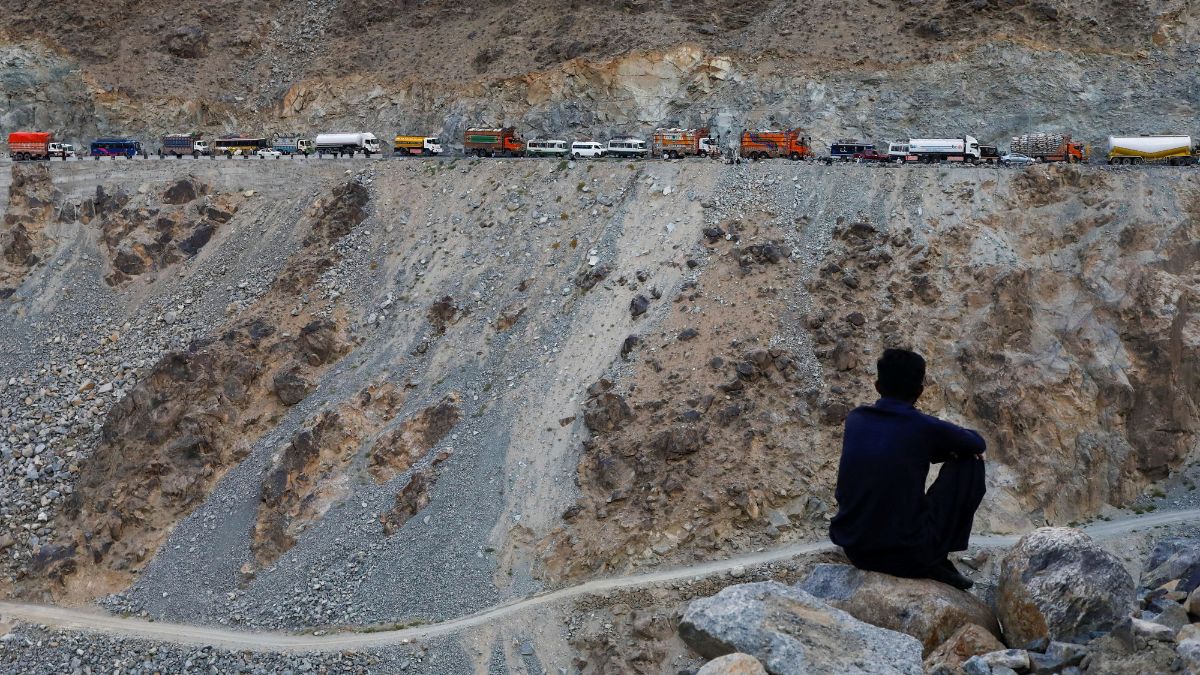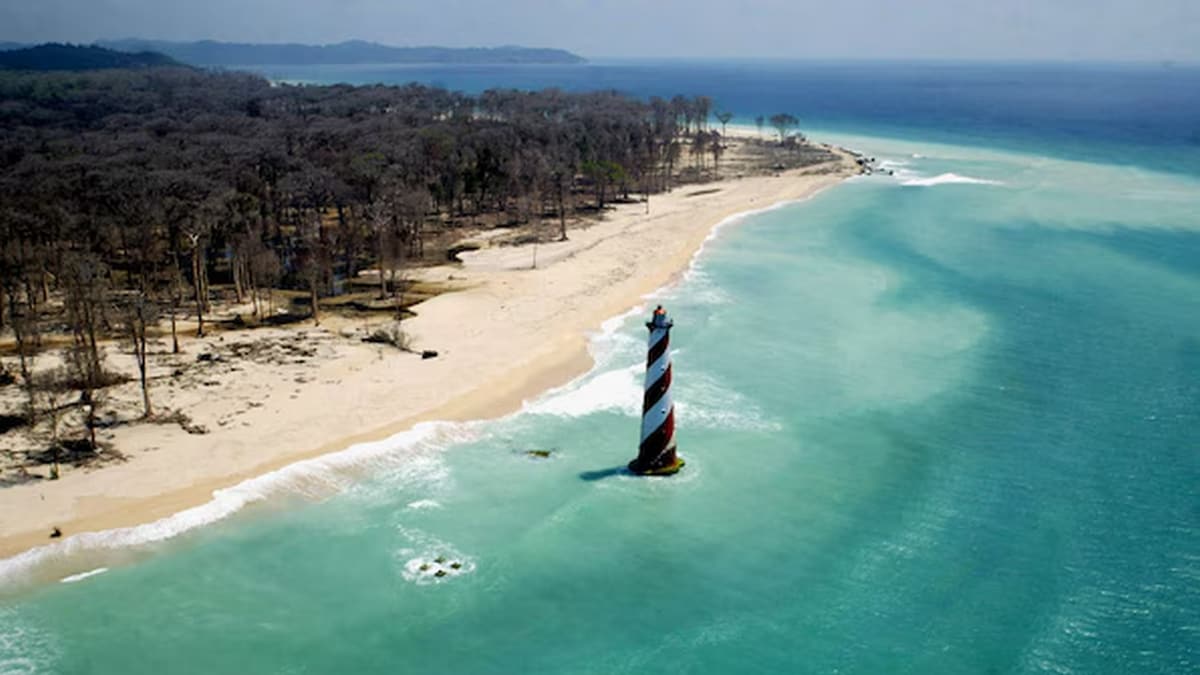What is the story about?
For more than a week, a vital section of the Karakoram Highway (KKH), Pakistan’s key link between Gilgit-Baltistan and the rest of the country, has been at a complete standstill.
What began as a local
protest in Harban, a village in Upper Kohistan, has now grown into a crisis affecting thousands of people and threatening to disrupt the progress of Pakistan’s most ambitious hydropower project — the Diamer-Bhasha Dam.
The demonstrations highlight growing tensions between local communities and authorities over compensation and resettlement for land taken for the massive dam.
For the seventh consecutive day, residents of Harban have blocked the Karakoram Highway at Harban Nallah, a key
point connecting Gilgit-Baltistan with Khyber-Pakhtunkhwa, reported Karachi-based news outletThe Express Tribune.
The blockade has stranded hundreds of trucks and passenger vehicles, bringing trade and travel to a grinding halt.
"Our land was seized, but compensation was unjust and long delayed," protest leader Niamat Khan said.
The protesters accuse the Water and Power Development Authority (WAPDA) and the provincial administration of failing to deliver on promises of fair payment.
According to
officials, around PKR 3 billion is owed to landowners. Nearly PKR 2 billion of this amount has already been transferred to the Kohistan deputy commissioner’s account, with the remaining funds pending due to what officials describe as “necessary legal formalities.”
Demonstrators have rejected these explanations, insisting on immediate and complete compensation. They argue that years of delays and inadequate rates have left affected families struggling to rebuild their lives.
As the standoff
continues, essential supplies have begun to run out. Trucks carrying food, medicines, and other goods remain immobilised on both sides of the blockade.
Perishable items such as onions and tomatoes are becoming scarce, causing a sharp rise in prices.
With the main highway blocked, transporters have been forced to reroute via Babusar Pass, a longer and more expensive alternative route. The increased cost of transport has added to inflation in a region already struggling with economic fragility.
Civil society activists and local traders have criticised the government’s response to the crisis, accusing both the Khyber-Pakhtunkhwa (K-P) and Gilgit-Baltistan (G-B) administrations of neglecting the plight of the people.
"Authorities in G-B and K-P appear indifferent while people suffer," said Mufti Kumail, a trader in Gilgit.
The impact has been particularly severe in Diamer Valley, where residents of Darel and Tangir areas are unable to travel to larger towns such as Chilas or Gilgit for healthcare, education, or trade.
Stranded families warn that if the deadlock persists, the region could face a humanitarian emergency.
Despite appeals from traders and residents for negotiations, protesters remain firm in their resolve. They have pledged to continue the blockade until their demands are fully met.
The Diamer-Bhasha Dam is located on the River Indus, straddling the boundary between Kohistan district in Khyber-Pakhtunkhwa and Diamer district in Gilgit-Baltistan.
Named after the nearby settlement of Bhasha, the site is approximately 40 kilometres downstream of Chilas and about 315 kilometres from the Tarbela Dam, one of Pakistan’s most important water reservoirs.
Once completed, Diamer-Bhasha will be the tallest roller-compacted concrete (RCC) dam in the world, with a planned height of 272 metres. It will create a massive reservoir covering an area of 200 square kilometres, capable of holding 8.1 million acre-feet (MAF) of water.
The dam
is designed to deliver multiple benefits:
Two underground powerhouses are planned — one on each side of the main dam — with six turbines each.
To date, WAPDA has spent PKR 78.5 billion on resettlement, infrastructure upgrades, and social development projects in the region.
These include the construction of schools, hospitals, and facilities such as the Chilas Cadet College, built at a cost of PKR 2.1 billion.
The construction of the Diamer-Bhasha Dam is a joint effort between China Power, a state-owned Chinese company, and Pakistan’s Frontier Works Organisation (FWO), which operates under the Pakistani military.
In May 2020, a contract worth USD 5.85 billion (PKR 442 billion) was signed for the project, making it one of the largest infrastructure deals under the China-Pakistan Economic Corridor (CPEC) framework.
China’s involvement
strengthens its strategic presence in the region, particularly as the dam is located close to the Chinese border.
For Beijing, the project offers both economic and geopolitical advantages, while for Pakistan it represents a critical step in addressing its chronic energy shortages.
However, India has strongly opposed the dam, as it is being built in Gilgit-Baltistan, a region India that is part of the former princely state of Jammu and Kashmir.
New Delhi has repeatedly stated that Pakistan’s decision to
proceed with construction violates India’s sovereignty.
While the Diamer-Bhasha Dam is touted as a green energy project, environmental experts have raised alarms about its ecological impact and carbon emissions.
The area where the dam is being built lies in a seismically active zone, with around 300 earthquakes recorded each month.
Building a massive concrete structure on the Central Asian fault line has prompted concerns about the safety of the dam
in the event of a major earthquake.
The creation of the 200-square-kilometre reservoir will submerge villages, farmland, and nearly 100 kilometres of the Karakoram Highway.
Over 35,000 people are expected to be displaced, while thousands of ancient rock carvings — some thousands of years old — will be permanently lost beneath the water.
The dam’s construction will require 12 million tonnes of steel and 22 million cubic metres of concrete, both of which are highly carbon-intensive.

Protesters block
Globally, cement production accounts for 8 per cent of carbon dioxide emissions, making large-scale concrete projects significant contributors to climate change.
A 2016 study of 1,473 dams worldwide estimated that, on average, hydropower without methane capture emits 273 kilogrammes of CO2 equivalent (CO2e) per megawatt-hour (MWh).
Since the Diamer-Bhasha Dam has no provisions for
methane capture, its emissions are projected to reach 321 kg CO2e per MWh over the first 30 years of operation — almost as high as coal-fired power plants.
Methane is a particularly potent greenhouse gas, released from the decomposition of organic material submerged in reservoirs. Without mitigation measures, the dam’s long-term environmental cost could rival that of fossil fuel-based energy generation.
The reduction of water flow downstream will likely accelerate seawater intrusion into the Indus Delta,
threatening its fragile ecosystems. Mangrove forests, which play a crucial role in protecting coastlines and supporting fisheries, have already suffered severe losses.
Between 1950 and 2005, the area covered by mangroves in the Indus Delta shrank from 380,000 hectares to just 87,000 hectares, largely due to reduced river flows caused by upstream dam construction.
Mangroves are among the world’s most carbon-rich trees, and their destruction accounts for up to 10 per cent of global emissions from deforestation, even
though they represent only 0.7 per cent of total forest cover.
Beyond its environmental impact, the Diamer-Bhasha Dam carries significant financial risks.
The social cost of carbon (SCC) — an estimate of the economic damage caused by each tonne of CO2 emissions — was placed by the International Monetary Fund (IMF) at USD 6.8-80 per tonne for 2020.
Based on projected emissions, the Diamer-Bhasha project could generate 170 million tonnes of CO2e over 30
years, resulting in potential societal costs ranging from USD 1 billion to USD 13 billion.
Given that Pakistan is far more vulnerable to climate change than wealthier countries, the true cost is likely to be even higher.
When these externalities are added to direct construction expenses and financing, analysts estimate the dam’s total cost to society could exceed USD 70 billion.
Critics argue that under such conditions, the project may never break even, let alone become a sustainable driver of economic growth.
The decision to prioritise the Diamer-Bhasha Dam over the long-debated Kalabagh Dam has also stirred controversy.
Engineer Anwer Khurshid has criticised the move, arguing that while Bhasha is valuable for storage and power generation, it cannot serve the same irrigation functions as Kalabagh due to the mountainous terrain.
"Bhasha dam is no substitute for Kalabagh dam not because of its altitude which is high enough, but because no irrigation canals can be taken out
from it because of the hilly terrain. No canals can be taken out from any dam on the Indus except from Kalabagh Dam," Khurshid told local media.
As construction progresses, thousands of families face displacement from their ancestral lands. WAPDA has undertaken various resettlement schemes, but locals say the compensation and rehabilitation plans fall short of what was promised.
With inputs from agencies
What began as a local
The demonstrations highlight growing tensions between local communities and authorities over compensation and resettlement for land taken for the massive dam.
Why are locals protesting?
For the seventh consecutive day, residents of Harban have blocked the Karakoram Highway at Harban Nallah, a key
The blockade has stranded hundreds of trucks and passenger vehicles, bringing trade and travel to a grinding halt.
"Our land was seized, but compensation was unjust and long delayed," protest leader Niamat Khan said.
The protesters accuse the Water and Power Development Authority (WAPDA) and the provincial administration of failing to deliver on promises of fair payment.
According to
Demonstrators have rejected these explanations, insisting on immediate and complete compensation. They argue that years of delays and inadequate rates have left affected families struggling to rebuild their lives.
As the standoff
Perishable items such as onions and tomatoes are becoming scarce, causing a sharp rise in prices.
With the main highway blocked, transporters have been forced to reroute via Babusar Pass, a longer and more expensive alternative route. The increased cost of transport has added to inflation in a region already struggling with economic fragility.
"Authorities in G-B and K-P appear indifferent while people suffer," said Mufti Kumail, a trader in Gilgit.
The impact has been particularly severe in Diamer Valley, where residents of Darel and Tangir areas are unable to travel to larger towns such as Chilas or Gilgit for healthcare, education, or trade.
Stranded families warn that if the deadlock persists, the region could face a humanitarian emergency.
Despite appeals from traders and residents for negotiations, protesters remain firm in their resolve. They have pledged to continue the blockade until their demands are fully met.
What do we know about the Diamer-Bhasha Dam project?
The Diamer-Bhasha Dam is located on the River Indus, straddling the boundary between Kohistan district in Khyber-Pakhtunkhwa and Diamer district in Gilgit-Baltistan.
Named after the nearby settlement of Bhasha, the site is approximately 40 kilometres downstream of Chilas and about 315 kilometres from the Tarbela Dam, one of Pakistan’s most important water reservoirs.
Once completed, Diamer-Bhasha will be the tallest roller-compacted concrete (RCC) dam in the world, with a planned height of 272 metres. It will create a massive reservoir covering an area of 200 square kilometres, capable of holding 8.1 million acre-feet (MAF) of water.
The dam
- Hydropower generation – With an installed capacity of 4,500 megawatts, it will generate about 18 billion units of electricity annually for the national grid, providing much-needed clean and low-cost energy.
- Water storage and Irrigation – The project will help irrigate 1.23 million acres of farmland, strengthening Pakistan’s agricultural output.
- Flood control – By regulating the flow of the Indus, the dam will reduce flood risks in downstream areas.
-
Extension of Tarbela Dam’s lifespan – By trapping sediment upstream, Diamer-Bhasha is expected to extend Tarbela Dam’s operational life by 35 years.
Two underground powerhouses are planned — one on each side of the main dam — with six turbines each.
To date, WAPDA has spent PKR 78.5 billion on resettlement, infrastructure upgrades, and social development projects in the region.
These include the construction of schools, hospitals, and facilities such as the Chilas Cadet College, built at a cost of PKR 2.1 billion.
What is China’s role in the Diamer-Bhasha Dam?
The construction of the Diamer-Bhasha Dam is a joint effort between China Power, a state-owned Chinese company, and Pakistan’s Frontier Works Organisation (FWO), which operates under the Pakistani military.
In May 2020, a contract worth USD 5.85 billion (PKR 442 billion) was signed for the project, making it one of the largest infrastructure deals under the China-Pakistan Economic Corridor (CPEC) framework.
China’s involvement
For Beijing, the project offers both economic and geopolitical advantages, while for Pakistan it represents a critical step in addressing its chronic energy shortages.
However, India has strongly opposed the dam, as it is being built in Gilgit-Baltistan, a region India that is part of the former princely state of Jammu and Kashmir.
New Delhi has repeatedly stated that Pakistan’s decision to
What are the environmental concerns around the Diamer-Bhasha Dam?
While the Diamer-Bhasha Dam is touted as a green energy project, environmental experts have raised alarms about its ecological impact and carbon emissions.
The area where the dam is being built lies in a seismically active zone, with around 300 earthquakes recorded each month.
Building a massive concrete structure on the Central Asian fault line has prompted concerns about the safety of the dam
The creation of the 200-square-kilometre reservoir will submerge villages, farmland, and nearly 100 kilometres of the Karakoram Highway.
Over 35,000 people are expected to be displaced, while thousands of ancient rock carvings — some thousands of years old — will be permanently lost beneath the water.
The dam’s construction will require 12 million tonnes of steel and 22 million cubic metres of concrete, both of which are highly carbon-intensive.

Protesters block
major highway in northern Pakistan over power outages in Aliabad, Hunza, Pakistan, January 7, 2025. File Image/Reuters
Globally, cement production accounts for 8 per cent of carbon dioxide emissions, making large-scale concrete projects significant contributors to climate change.
A 2016 study of 1,473 dams worldwide estimated that, on average, hydropower without methane capture emits 273 kilogrammes of CO2 equivalent (CO2e) per megawatt-hour (MWh).
Since the Diamer-Bhasha Dam has no provisions for
Methane is a particularly potent greenhouse gas, released from the decomposition of organic material submerged in reservoirs. Without mitigation measures, the dam’s long-term environmental cost could rival that of fossil fuel-based energy generation.
The reduction of water flow downstream will likely accelerate seawater intrusion into the Indus Delta,
Between 1950 and 2005, the area covered by mangroves in the Indus Delta shrank from 380,000 hectares to just 87,000 hectares, largely due to reduced river flows caused by upstream dam construction.
Mangroves are among the world’s most carbon-rich trees, and their destruction accounts for up to 10 per cent of global emissions from deforestation, even
What could Pakistan actually end up paying for the dam?
Beyond its environmental impact, the Diamer-Bhasha Dam carries significant financial risks.
The social cost of carbon (SCC) — an estimate of the economic damage caused by each tonne of CO2 emissions — was placed by the International Monetary Fund (IMF) at USD 6.8-80 per tonne for 2020.
Based on projected emissions, the Diamer-Bhasha project could generate 170 million tonnes of CO2e over 30
Given that Pakistan is far more vulnerable to climate change than wealthier countries, the true cost is likely to be even higher.
When these externalities are added to direct construction expenses and financing, analysts estimate the dam’s total cost to society could exceed USD 70 billion.
Critics argue that under such conditions, the project may never break even, let alone become a sustainable driver of economic growth.
What is the Kalabagh vs Diamer-Bhasha debate?
The decision to prioritise the Diamer-Bhasha Dam over the long-debated Kalabagh Dam has also stirred controversy.
Engineer Anwer Khurshid has criticised the move, arguing that while Bhasha is valuable for storage and power generation, it cannot serve the same irrigation functions as Kalabagh due to the mountainous terrain.
"Bhasha dam is no substitute for Kalabagh dam not because of its altitude which is high enough, but because no irrigation canals can be taken out
As construction progresses, thousands of families face displacement from their ancestral lands. WAPDA has undertaken various resettlement schemes, but locals say the compensation and rehabilitation plans fall short of what was promised.
With inputs from agencies
Do you find this article useful?















